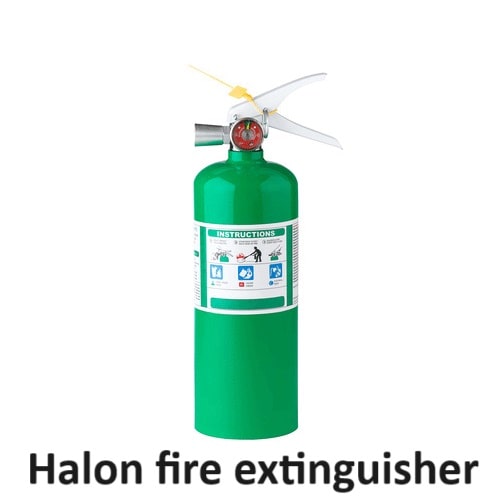Halon fire extinguishers contain halon extinguishing agents to suppress fires. Basically, Halon fire extinguisher is toxic in nature and they are used for aircraft fire and some other areas like sensitive and expensive computer fire, etc because they leaves no residue and does not cause damage to sensitive electronics. These extinguishers have been widely used due to their fire-extinguishing properties. Halon is a colorless, odorless, and non-conductive gas.
Nowadays Halon fire extinguisher is banned because of toxic gas like methane. Halon fire extinguishers are potent greenhouse gases that deplete the ozone layer. As a result, the production and use of halon fire extinguishers have been banned in many countries under international agreements such as the Montreal Protocol.

Table of Contents
Halon fire extinguisher class:
The halon fire extinguishers are used for class B and class C-type fires.
Halon fire extinguisher uses:
Halon fire extinguishers are used in:
- Used for Aircraft fire.
- Used for laboratory chemicals and equipment fire.
- Used for sensitive and expensive computers fire.
- Most useful for tapes and films fire.
- Useful for class B and Class C type fires.
Types of halon fire extinguishers:
There are two types of halon fire extinguishers.
BCF 1211 (Bromochloro di fluoro methane)
- BCF halon fire extinguishers are also known as 1211 halon fire extinguishers.
- It is also known as BrCIF2.
- Halon 1211 is used only in portable extinguishers.
- It is a streaming agent.
BTF (Bromo tri fluoro methane)
- BTF fire extinguishers are also commonly known as 1301 halon fire extinguishers.
- It is also known as CBrF3.
- Halon 1301 is used only in fixed extinguisher installations.
How do Halon fire extinguishers work?
Halon fire extinguishers work like other fire extinguishers, when it is discharged, it removes the oxygen element of the fire, and extinguish the fire.
What is halon gas?
Halon gas is a blend of bromine, fluorine, and carbon.
Halon fire extinguisher health effects:
There are some health effects of halon fire extinguishers are noticed, such as:
- Asphyxiation.
- Frostbite.
- Burns to the skin.
- Eye irritation.
- Inhaling halon fire extinguishers can cause dizziness, unconsciousness, and tingling in the arms and legs.
- It may also cause cardiac sensitization resulting in irregular heartbeats and even heart attacks.
Alternatives of Halon fire extinguisher:
In recent years, alternative fire extinguishing agents, like FM-200, and Novec-1230, and CO2, have been developed to replace the halon in fire protection systems. The alternatives are less harmful to the environment as well as the human body.
Halon Fire Extinguishers in the Aviation Industry:
The aviation industry continues to use Halon fire extinguishers in the protection of valuable avionics and sensitive equipment. Safety protocols and regulations are stringent.
Safety Precautions when Using Halon Fire Extinguishers:
When using Halon fire extinguishers, it’s crucial to follow safety guidelines. These extinguishers can displace oxygen, posing a risk to humans. Proper training is essential.
Why halon fire extinguishers are Banned?
While using halon fire extinguishers it produces decomposition by-products such as hydrogen chloride, hydrogen bromide traces of free halogens, etc.
Maintenance and inspection of halon fire extinguisher:
Regular maintenance and inspection of fire extinguishers are essential to ensure their reliability during a fire emergency. Checking pressure, seals, and labels is a vital part of fire safety.
History of the halon fire extinguisher:
The halon fire extinguishers were developed in the 1950s. After that, these became more popular in the mid-20th century for their effectiveness in safeguarding sensitive electronic equipment in server rooms, aircraft, and laboratories, (i.e., they leave less residue and do not cause damage to the equipment.
Conclusion:
Halon fire extinguishers are toxic and it affects the environment and the human body. If you have a halon fire extinguisher, it’s important to check local regulations and guidelines for its use and disposal. Choosing the right fire extinguisher is a matter of assessing the specific risks in your environment and complying with regulations.
Faqs on the Halon fire extinguisher?
Are Halon fire extinguishers still available for purchase?
Halon fire extinguishers are no longer manufactured, but some may still be available as pre-owned units.
Why is Halon harmful to the environment?
Halon depletes the ozone layer, contributing to environmental damage.
What are the alternatives to Halon fire extinguishers?
Alternatives include FM-200, Novec 1230, and CO2 fire extinguishers, among others.
Can I use a Halon fire extinguisher on any type of fire?
Halon is best suited for Class B and C fires, such as those involving flammable liquids and electrical equipment.
How often should I inspect my Halon fire extinguisher?
Regular inspections are recommended, typically on an annual basis, to ensure the extinguisher is in good working condition.
What is a halon fire extinguisher used for?
The halon fire extinguishers are used for class B and class C-type fires.
What color is a halon fire extinguisher?
Green is the color used in the halon fire extinguisher.
Are Halon fire extinguishers banned in India?
Yes, Halon fire extinguishers are banned in India.
